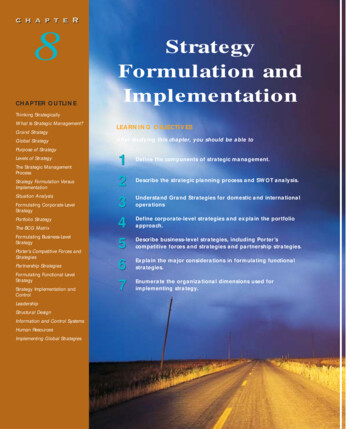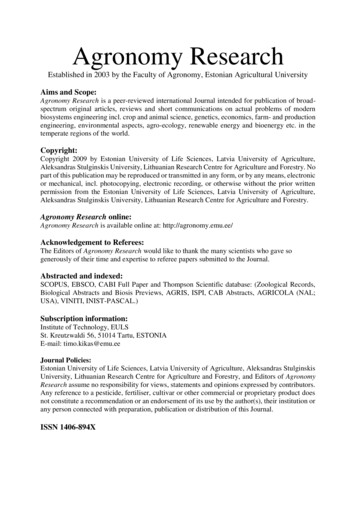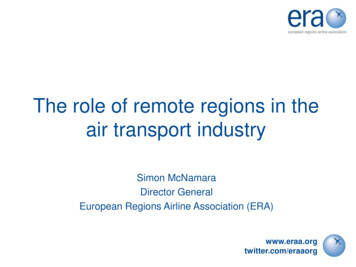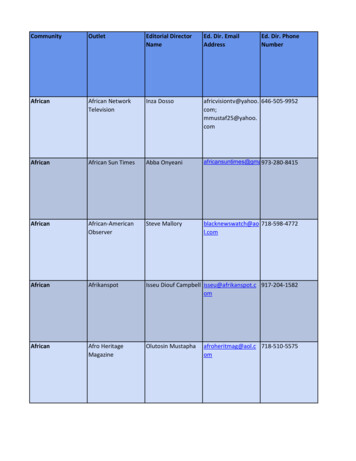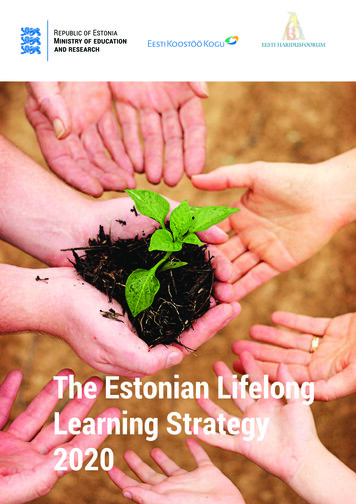
Transcription
The Estonian LifelongLearning Strategy2020
Contents2Introduction2GENERAL GOAL AND BASIC PRINCIPLES4VISION AND STRATEGIC GOALS FOR 20205ANALYSIS OF THE CURRENT SITUATION: the advances and obstacles of the lifelong learning system7STRATEGIC GOALS AND MEASURES71. A change in the approach to learning102. Competent and motivated teachers and school leadership123. The concordance of lifelong learning opportunities with the needs of the labour market144. A digital focus in lifelong learning165. Equal opportunities and increased participation in lifelong learning20IMPLEMENTING THE STRATEGY21Annex 1: Key indicators for achieved goals24Annex 2. Terminology
IntroductionWhat Estonia needs is a shared understanding of the direction to take when moving towards aknowledge and innovation-based society. We are successful only when we acknowledge the need toconstantly learn and relearn and to be proactive and creative, so that we can cope in today’s rapidlychanging world. Learning and the knowledgeable application of skills must become an integral partof an active approach towards life.The Lifelong Learning Strategy is a document that guides the most important developments in thearea of education. It is the basis on which the government will make its decisions for educationalfunding for the years 2014-2020 and for the development of programmes that support theachievement of necessary changes. The goals and measures of the Lifelong Learning Strategy areconcordant with the national reform programme “Estonia 2020”, with the Estonian national strategyfor sustainable development, “Sustainable Estonia 21”, and with the fulfilment of the educationrelated goals of the “National Security Concept of the Republic of Estonia”.Unlike earlier attempts to draft an education strategy, the current one is a strategy of choices. Itspecifically addresses the most important obstacles in the area of lifelong learning. It is criticallyimportant for society to remove these obstructions, because they impact on the achievement of theagreed goals. Several international tests1 have shown that education in Estonia is of a good quality:the skills of our students who have completed basic and secondary education are above averagecompared to their peers in other developed countries, whereas the results of our young people withhigher education rank only as average. International comparisons, however, have also shown whereour problems lie – there is a lack of resolve and creativity in using different skills in new contexts, thedecline in age-related skills proficiency is too rapid, and older generations have lower informationprocessing skills and lack the courage to use computers. Our formal education provides a good basis,but skills have to be actively used in daily activities as well as in work life, since the principle “use itor lose it” really does apply. We have to openly acknowledge that unused skills have no intrinsic valuein themselves.Opportunities for acquiring new knowledge and skills can be found in the workplace, throughextracurricular activities and youth work, as well as by participating in the activities of civil societyorganisations or in a virtual space, where a person can learn either individually or with others.Various social networks, cultural institutions, military service, as well as the home environment, allplay a role in developing and supporting the curiosity and motivation to learn, as well as in shapingstudy habits and value judgements.The Estonian Lifelong Learning Strategy considers every individual as a learner – children as well asyouth and adults. Learning must become an integral part of an individual’s active approach towardslife, including among those who are older. Collectively, teachers are those professionals who guidelearning processes and develop learning environments in kindergartens, general schools, vocationalschools, higher education institutions, hobby schools, non-formal and informal education centres,in-service education centres, open youth centres, museums and other cultural institutions. Theterm school leadership includes the Heads of these learning institutions. The approach to learningincludes an understanding of the nature of learning, its goals, methodology and the role of all thevarious parties involved in the learning process. Terminology is explained further in Annex 2.The general goal of drafting the Lifelong Learning Strategy is to provide all people in Estoniawith learning opportunities that are tailored to their needs and capabilities throughout their wholelifespan, in order for them to maximize opportunities for dignified self-actualization within society,in their work as well as in their family life.The Lifelong Learning System - 2020 is measured by the following key indicators2.1.Participation rate in lifelong learning among adults (% of25-64- years old who stated that they had received educationor training during the four weeks preceding the survey)2. Percentage of adults (25-64) with general education only(no professional or vocational education)3. Early leavers from education and training (% of thepopulation aged 18-24 with at most lower secondaryeducation and not in further education or training)4. Top achievers in basic skills (the percentage of topperformers)3Developing the Lifelong Learning Strategy has been a two-stage process. In cooperation withthe civil society organizations, the Estonian Cooperation Assembly and the Estonian EducationForum, the Ministry of Education and Research initiated the project “Five Challenges in EstonianEducation – Education Strategy for 2012-2020” during the period of 2009-2011. This document wasa starting point for discussions in the task force that included experts from the fields of educationand the labour market who were responsible for compiling the current strategy in 2013. During thedevelopment of the strategy, an advisory body, mainly composed of the experts who had createdthe original document on the five challenges in Estonian education, was consulted. The Governmentofficially approved the Estonian Lifelong Learning Strategy on February 13, 2014. In compiling thestrategy, the results and written commentaries of discussions with different stakeholders was takeninto account.a) Readingb) Mathematicsc) Science5. Employment rate of recent graduates (20-34 years oldgraduates; one to three years after leaving education)6. Digital competences (individuals aged 16-74 with computerskills, %)7. Comparison of general education teachers’ salaries (ratioof salaries to earnings for full-time, full-year workers withtertiary education aged 25 -64)8. Stakeholders’ satisfaction with lifelong learning(central, regular survey)4General goal and basic principlesIn addition to the formal education system (kindergarten, basic school, upper-secondary school,vocational institutions, higher education institutions), lifelong learning also includes in-serviceeducation and retraining as well as non-formal and informal education in all its diversity.1PISA 2006, 2009 ja 2012, PIAAC 20132342Goal level 2020Starting level20%12.9% (2012)Not over 25%30.3% (2012)Below 9%10.5% (2012)10%16%14.4%8.4% (2012)14.6% (2012)12.8% (2012)At least 82%73.9% (2012)80%65% (2012) 1.00.64 (2011)Satisfactionhas increasedThe Lifelong Learning Strategy plays an important role in achieving the general objectives of the “Estonia 2020”programme – several of the actions outlined for Goals 3 and 5 of this Strategy are directly aimed at improvingproductivity and increasing employment, while all strategic goals are indirectly related. The first three key indicatorsoverlap with the main objectives of “Estonia 2020”, and the first and third key indicators overlap with the indicatorsin the Action Programme of the Goverment of the Republic.Share of students who reached PISA levels 5 and 6; the goal level will be measured in the 2018 PISA test.An overview of the dynamics of the listed indicators is shown in Annex 1.3
The following principles are significant in developing the lifelong learning system: The learner’s active participation and responsibility; Cooperation and learning from each other; The quality, flexibility, transparency and trustworthiness of learning opportunities; Consideration of special needs in the organization of studies and learning environments; Gender equality; Openness, tolerance and international cooperation; Continuity of the Estonian state, its language and culture; Sustainable development; Evidence-based decision-making.When implementing the Strategy, its success is dependent on whether all the important stakeholdersaccept responsibility and carry out the following tasks: The learner participates in learning in a responsible manner and consciously charts their owneducation path;Theparent supports the learner, ensuring that the child fulfils the obligation of mandatory school attendance, at least for the duration of the child’s basic education;Theteacher creates an environment that supports learning and development, sets learning goals that are appropriate for the learner, and develops his or her own professional skills purposefully;TheHead of an educational institution provides the strategic leadership for the institution, creates an organizational culture that supports learning and development, and supports the professionaldevelopment of teachers; The local government ensures access to good quality preschool and basic education in closeproximity to home, as well as the necessary support services. Employers describe their expectations of the education system and provide learners withpositions for internships, apprenticeships, etc., and create opportunities for their own employeesto participate in lifelong learning;TheState, with its regulatory powers, guarantees good quality and diverse opportunities for acquiring upper-secondary, vocational and higher education, as well as career counselling andpertinent information about the labour market.Vision and strategic goals for 2020Vision for 2020: Learning is a lifestyle. Development opportunities are noticed andsmart solutions are pursued.What isdifferentin 2020?WE TAKERESPONSIBILITYPeople understandthat learning andself-development aretheir own choice andresponsibility.WE CARE FORDEMANDWE PROVIDEOPPORTUNITIESStudies are based onthe learner’s interestsand capabilities,they support or herdevelopment andmeet labour marketneeds.The lifelong learningsystem as a whole offersstudy opportunitiesthat are of good quality,modern, flexible and caterto the special needs of thelearner.1.2.3.4.5.Analysis of the current situation:the advances and obstacles of thelifelong learning systemIn determining the advances and obstacles of the lifelong learning system, the background materialsfor “Five challenges in Estonian education – Education Strategy 2012–2020” as well as thedocument “A smart and active people”, compiled and renewed annually by the Ministry of Educationand Research, were used. These documents provide a thorough overview of the education trendswithin Estonia, as well as in relation to developments in the EU.The main points that indicate advances and obstacles are as follows5:ADVANCES1. Education is highly valued in Estonian society – throughout history it has been considered as thecornerstone for individual success, as well as the main driver of the nation’s development.2. International comparative studies show that most learners acquire good basic skills.3. The socio-economic background of learners has a low impact on their learning results6.4. Participation in lifelong learning has increased.5. The incidence of school dropout has decreased in basic schools.6. Children’s participation in preschool institutions is high, which creates a sound basis for asmooth transition to school life.7. There are reliable databases for monitoring the progress of learners, education institutions andlearning results. This allows resources to be allocated where they are needed most.8. Using language immersion methods has delivered good results and has increased the level ofintegration of Russian-speaking youth into Estonian society7.9. Alternative approaches incorporated in programmes such as Noored Kooli (TeachFirst) and5To pursue the vision and the general goal, 5 strategic goals have been established:(A table of indicators measuring the achievement of these goals is included in Annex 1)4Change in the approach to learning. Implementation of an approach to learning that supportseach learner’s individual and social development, the acquisition of learning skills, creativity andentrepreneurship at all levels and in all types of education.Competent and motivated teachers and school leadership. The assessments of teachers andheadmasters including their salaries are consistent with the qualification requirements for thejob and the work-related performance.Concordance of lifelong learning opportunities with the needs of labour market. Lifelong learningopportunities and career services that are diverse, flexible and of good quality, resulting in anincrease in the number of people with professional or vocational qualifications in different agegroups, and an increase in overall participation in lifelong learning across Estonia.A digital focus in lifelong learning. Modern digital technology is used for learning and teachingeffectively and efficiently. An improvement in the digital skills of the total population has beenachieved and access to the new generation of digital infrastructure is ensured.Equal opportunities and increased participation in lifelong learning. Equal opportunities forlifelong learning have been created for every individual.67An overview of the dynamics of the listed indicators is shown in Annex 1.„Eesti PISA 2009 kontekstis: tugevused ja probleemid. Programmi Eduko uuringutoetuse kasutamise lepinguaruanne 2012“, http://www.hm.ee/index.php?048181.„Hilise keelekümbluse mõju. Uuringu tulemuste aruanne“, http://www.hm.ee/index.php?0481815
Tagasi Kooli (Back to school), as well as private schools, Waldorf schools and the NGO Hea Algus(Step by Step), have made the formal education system more flexible, innovative and diverse.10. Learning and working conditions in vocational schools and higher education institutions aremodern.11. The network of vocational schools has been organized in a more efficient way.OBSTACLES1. The understanding of a new approach for learning has been adopted only in theory. All Legal Actsgoverning national and education institutions establish how the different types of talents andspecial needs should be identified and valued, but this approach has not become an integral partof the learning process8.2. The incidence of ‘school dropout’ (especially among males) is high across all levels and types ofeducation.3. Attitudes that have developed in society influence learners towards choosing “male and femalespecialities”, which increases gender segregation in the labour market9.4. Approximately one third of the working age population in Estonia does not have a professionalor vocational education; the participation rate in lifelong learning among those with low levels ofqualifications is limited.5. There is a substantial mismatch of skills. There is a considerable difference between what isoffered by the education and training system and what the labour market needs. Educationinstitutions and representatives of employers do not collaborate sufficiently to develop thelifelong learning system.6. There is a prevailing attitude in society that learning is only for young people. Besides financiallimitations, self-development is also inhibited by a lack of interest and motivation among adults.7. Teaching as a profession is not attractive: the proportion of young people, particularly males,in the teaching profession is low, interest in enrolling in the teacher education programmes islimited, and among those who have trained to be teachers, many choose not to work in schools.8. Collection of information regarding labour market developments and the economy is notsystematic and career counselling is of an uneven quality and accessibility10.9. The current network of upper-secondary schools has not taken into account the significantdecrease in the number of students and small upper-secondary schools cannot guaranteediverse, quality learning opportunities.10. Vocational education is not recognized as an opportunity for good quality studies, and the labourmarket lacks skilled workers with the appropriate qualifications.11. A rapid transition to very high numbers of students obtaining higher education has led to adecline in the standards of quality. The problem solving skills of Estonian youths with highereducation are low compared to their peers in other countries11. The international mobility ofuniversity students and teachers is low.12. Russian-language basic schools do not provide good Estonian language skills and the basicskills of students in those schools is lower than in Estonian-language schools.13. Teachers’ access to the digital infrastructure and learning materials is limited and inconsistent.14. Approximately one third of the working age Estonian population12 lacks even minimal ICT skillsand the existing skills are insufficient for working13.“OECD rahvusvahelise õpetamise ja õppimise uuringu TALIS tulemused“, http://www.hm.ee/index.php?048181“Eesti põhikooli efektiivsuse uuring“, http://www.hm.ee/index.php?popup download&id 11759For example, the share of female learners in sciences and technology is 31%.10http://vana.innove.ee/orb.aw/class file/action preview/id 36529/Karjaariteenuste susteemi uuring loppraport.pdf11“Täiskasvanute oskused Eestis ja maailmas. PIAAC uuringu esmased tulemused“, 2013. Peatükk 3.4. “Hariduslikjaotus“.12Internet skills and use: NET%20USE%20AND%20SKILLS.pdf lk 838136According to a labour market study conducted by Statistics Estonia, 76% of respondents evaluate theircomputer skills to be sufficient in order to seek or change employment within the upcoming year.15. Society places too much emphasis on the results of national examinations when assessing thequality of education and schools.16. An evidence-based approach in decision-making and in the development of education policy hasnot become universal which makes reaching consensus in education policy choices difficult.Strategic goals and measures1. A change in the approach to learningAll curricula adopted in formal education at the State level during the past decade have emphasizedthe focus on the learner, key competences, the necessity to incorporate new knowledge with theexisting knowledge in the learning process, integrating studies with different subjects and fields,learning/teaching not only factual knowledge, but also how to learn and solve problems, includingthe team approach to problem solving. Efforts in these coming years must be directed towardsimplementing these requirements. A teacher in the 21st century, whether in a school, universityor in adult education, is not a source of information. Rather, a teacher is a person who createsconnections and shapes value judgements, whose task is to develop critical and creative thinkingin a student, as well as analytical and entrepreneurial skills, team work skills and written and oralcommunication skills. The teacher’s role is to support a student’s path towards becoming a learnerwho can manage their own learning, who can cope with changes in their surroundings independently,and who takes responsibility for their own development and learning. In order to give weaker learnersthe ability to cope and to challenge the stronger learners at the same time, teachers and the teamsof supporting specialists need to approach each learner individually.The goal is to implement an approach towards learning that supports each learner’s individual andsocial development, learning skills, creativity and entrepreneurship in the work of all levels and typesof education.Strategic measures1.1. Ensuring content and volume of studies are concordant with curricular objectivesThe content and volume of studies must be concordant with the objectives and learning outcomesoutlined in curricula (including key competences).Individual curricula in nearly all levels and types of education now include objectives that take intoaccount the learning outcomes, including key competences that have been described in variousnational and international regulations and professional standards14. In order to assess whether thelearning content, volume, methodology and assessment support the achievement of the set objectivesand the acquisition of key competences, the following actions are necessary: 14The Ministry of Education and Research will launch an analysis and, if necessary, make changes inthe content and volume of the national curricula in basic and upper-secondary schools;At vocational and higher education levels, the topics for analysis deal with the coherence betweenThe Recommendation of the European Parliament and of the Council of 18.12.2006 defines the following keycompetences: communication in the mother tongue; communication in foreign languages; mathematicalcompetence and basic competences in science and technology; digital competence; learning to learn; socialand civic competences; sense of initiative and entrepreneurship; cultural awareness and expression. Thestrategy especially emphasises the necessity to develop creativity and entrepreneurship, problem solving andteamwork skills, critical thinking and analytical skills, as well as digital competence.7
learning methods, the volume of contact hours and independent work, the share of practical work,grading methods, the relation between the objectives of the curricula and the learning outcomes,as well as how effectively the needs of the labour market are met. Proposals for changes will bemade taking into account the best experiences on an international level.1.2. Changing assessment and evaluation principlesIn assessing the results of a learner as well as the education institution as a developing institutionitself, the emphasis is moving towards formative assessment that supports learning and theindividual development of each learner. In formative assessment, both the assessed and theassessor – the learner and the teacher – set the bar at a height where it can be achieved witheffort. Therefore, the main focus is not so much on assessing the end result, but rather on lookingat the point of departure, setting objectives together, and choosing the ways and means that wouldmost efficiently support achieving the set goals. The learner is no longer an object but a subject,participates in planning the learning process, takes responsibility for achieving results, and receivesfeedback from the teacher, first and foremost on the key competences that were agreed upon aheadof time.In the national external evaluation system, more attention should be paid to assessing keycompetences and integrating subjects in all levels and types of education, on study developmentwork – on a holistic approach to management.Examinations, standardized tests, and the external and internal evaluation of educationalinstitutions will be used to assess the extent to which the institution has been able to implementthe new approach to learning. This also includes assessing whether the learners have acquiredthe knowledge and key competences outlined in the curricula, and whether an environment thatsupports each learner’s individual and social development has been created.In both the assessment of learners as well as institutions, it is very important to find the rightbalance between summative and formative assessment and to develop the institution’s self-analysisand reflection skills. Assessment results are analysed in their dynamics and a differential approachis implemented: the stronger ones get recognition, while the schools with weaker results areprovided with the suitable assistance they might need.Necessary activities: Assessment tools for assessing the learners’ development in key competences will be created; For national exams, other external exams and standardized testing, methods will be developedand implemented in order to assess key competences and problem solving skills;Togetherwith stakeholders, the Ministry of Education and Research will develop quality indicators that will measure the learning and educational processes’ results, effectiveness and stakeholdersatisfaction. The results for all institutions will be publicly available and comparable betweeninstitutions.Externalevaluation criteria for educational institutions will also be developed. These will support the implementation of this strategy in secondary, vocational and higher education. The externalevaluation will be connected to the institution’s self-analysis, which will have an emphasis onthe learning and educating process, its effectiveness and results, as well as the results of thestakeholder satisfaction questionnaire. The external evaluation will give the educational institutioncompetent feedback, and the application of suggested improvements outlined in the report will besupported.81.3. Developing an in-service education system for the teachers and the Heads of basic schools,kindergartens and vocational schoolsThe main focus here would be rethinking the role of the Head of a school as well as that of theteachers, so that they would be able to create an atmosphere in which attention would be paid tothe development of each learner, to the development of their potential, and to valuing individualdifferences. Additionally, there needs to be a reasonable balance in the in-service education ofsecondary and vocational school teachers between what the State offers (and centrally coordinates)and the training that is particular to a school’s specialization and the career development needs ofthe teachers. The in-service training system will be structured in a way that good quality courseswould be guaranteed and would take into account the specialized nature of the educationalinstitution.Necessary activities: Teacher education institutions will develop initial and in-service education curricula thatsupport the objectives of the strategy and that are closely integrated with practical work. Theseinstitutions will use efficient teaching methods and flexible learning to motivate teachers to applytheir acquired knowledge and skills in their work;In-servicecourses will be offered to vocational school teachers at the State level, in order to better integrate general and vocational courses, emphasizing the importance of acquiring keycompetences. Opportunities to update their skills and knowledge base will be set up for vocationalteachers in workplaces;Thoseoffering in-service courses for school leadership will focus on the management of learning and developmental processes, as well as on the implementation of the new approach to learning; In order to guarantee the quality of in-service education and retraining, quality standards fortraining will be developed for the providers and State funds will be used only for those trainingcourses that are in compliance with the quality requirements; Educational institutions will create more flexible opportunities for retraining teachers (newsubjects, additional educational technologist competences, special education competence, etc.); Opportunities will be created for alternate educational and work experience related routes to theteaching profession.1.4. Creating and supporting forms of cooperation that support the implementation of the approachto learningCooperation in all its diverse forms is the key to success in the education system: it is very importantto have cooperation with teachers and educational institutions, the school and parents, but alsobetween the school and the local government and the local private sector. Integrating extracurriculareducation with formal education and teaching outside of the school environment (in companies,youth centres, nature and environment centres, museums, libraries, and other cultural institutions)enriches the learning process. Special attention needs to be given to the inclusion of Russianlanguage schools in joint projects and support for their initiatives. Besides local cooperation,including international experience and expertise in all levels of education is of critical importance forEstonia.Necessary activities: Introducing the new approach to learning and discussing implementation options in local contexts,including all the important stakeholders (the learner, teacher, school leader, parent, school owner,local cultural institutions, the private sector);TheMinistry of Education and Research will launch a programme to support cooperation between teachers and educational institutions, learning from each other, as well as carrying out jointprojects with cultural institutions and businesses on all levels of education; also, cooperationbetween teachers (including university) in integrating learning outcomes and key competences,9
cooperation between teachers and support staff in solving students’ behavioural problemsand analysing learning difficulties, developing new methods for cooperation between teachersin upper-secondary schools and universities, carrying out studies on activities, joint projectsbetween university teaching staff and researchers, participation in international cooperationprojects and comparative studies, etc.1.5. Developing Centres of CompetenceTallinn University and the University of Tartu are responsible for the areas of teacher education andeducational research, and for launching an educational research programme. The choice of topicswill be based on the national education strategy priorities and directed towards developmental needsat all levels of education. Both universities will set teacher education and educational sciencesas their priority fie
changing world. Learning and the knowledgeable application of skills must become an integral part of an active approach towards life. The Lifelong Learning Strategy is a document that guides the most important developments in the area of education. It is the basis on which the government will make its decisions for educational


